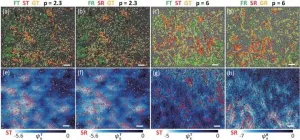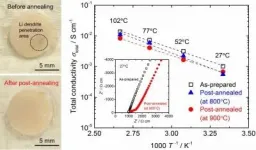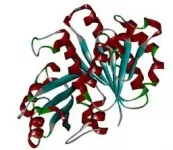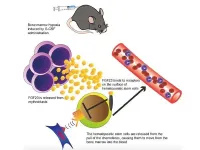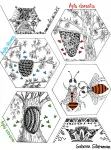(Press-News.org) INSECTS The spirea aphid, Aphis spiraecola, an invasive pest, has been discovered for the first time in Denmark by University of Copenhagen researchers. The extent of its current distribution remains unknown, but in time, it could prove to be a troublesome pest for Danish apple growers.
Aphis
Whether the discovery of this aphid in Denmark is an isolated incident, or if the species has made itself at home due to a milder climate, remains unknown to the researchers. Closer investigation is needed. Photo: UCPH/Uni.Budapest
In a collaboration with colleagues at the University of Budapest, University of Copenhagen researchers have analysed and compared a number of samples of green aphids from apples around the world and discovered a new apple-loving pest in Denmark.
The bright greenish yellow spirea aphid--Aphis spiraecola-- which most likely originates in East Asia, has gradually become a widespread pest in tropical and temperate regions around the planet. While it is especially problematic for citrus and apple trees, it can attack many other plant species. The aphid has been in the United States for the last 100 years and was discovered in Mediterranean countries in 1939. However, the spirea aphid has never been witnessed in the Nordic countries before.
"It is a serious pest that is more well known in countries a touch warmer than Denmark and is particularly harmful to citrus crops. It was identified in Germany in 2000, and the Baltic states a few years later. Now, it is here in Denmark. So, this is definitely something that we need to keep an eye on, as it could prove to be problematic for Danish apple growers," warns Associate Professor Lene Sigsgaard of the University of Copenhagen's Department of Plant and Environmental Sciences. For the past 20 years, Sigsgaard has researched natural predators and pest regulation in apple and other species.
Sucks nourishment out of the plants upon which it poos
Fact Box
Species: Aphis spiraecola Patch, also known as the spirea aphid or green citrus aphid (Hemiptera, Aphididae)
Physical appearance: Bright greenish yellow to apple green aphid easily confused with the green apple aphid (Aphis pomi), yet with minor morphological differences. The aphid often occurs in mixed colonies of other aphids.
Origin: Probably East Asia
Distribution: Now widespread over tropical and temperate regions worldwide. Can be spread with plant material. Winged generations during spring and late summer allow the species to spread themselves.
Host plants: Spirea, citrus, and apples are primary hosts where eggs are laid. The species also attacks other seed fruits, stone fruits, etc., and in the tropics, species including cocoa. The aphid can live on at least 20 different plant genera, making it very polyphagous.
Life: Across most of its range, the species reproduces asexually year-round (females give birth to new females without mating). In Denmark, the vast majority of aphid species winter as eggs, except for the peach aphid. Whether this new species will winter in Denmark as eggs or aphids in large numbers is unknown.
Impact: Commonly attacks citrus and apple trees. Aphids suck nourishment from plants. Sooty mold growing in honeydew can decrease a plant's ability to photosynthesize. The aphid causes apple leaves to curl and may cause the tips of branches to produce abnormally little growth. Severely-infested leaves become small, bright and may fall prematurely. Symptoms are similar to those caused by green apple aphids.
Viruses: The species is a virus vector for several species including CTV on citrus and plum pox virus.
Read the research article:
https://static-curis.ku.dk/portal/files/253648977/108_2020_PPS.pdf
Aphids have specialised mouth parts designed to pierce and suck nourishment from plants. Their liquid excrement, honeydew, is characterized by sticky areas on leaves and fruit. Sooty mold spores are captured by and can grow in the sticky honeydew coating a leaf, causing affected leaves to become dark, which blocks sunlight and reduces photosynthesis.
"Aphids can affect a plant in several ways. Among other things, they suck nourishment from plants, energy that would have otherwise been used to produce new shoots and fruits. This stresses plants and can reduce yields in both the current and following season," explains Lene Sigsgaard.
While the rosy apple aphid is currently enemy number one in Danish apple orchards, the bright green spiraea aphid could cause problems too. Only the future can tell what this little sucker's ultimate impact will be.
Virus spreaders
Aphis spiraecola is a virus vector on citrus fruit and can also spread plum pox virus, also called Sharka, which has yet to be observed in Denmark.
Whether the discovery of this aphid in Denmark is an isolated incident, or if the species has made itself at home due to a milder climate, remains unknown to the researchers. Closer investigation is needed.
Its natural predators, which typically keep aphid populations in check and limit damage, could help to regulate this invasive new aphid.
With increased biodiversity in and around orchards and fields, readily catalyzed by planting flowering hedges and flower rows, populations of natural predators such as ladybirds, green lacewings, spiders, kissing bugs and parasitoid wasps can be supported to combat and reduce aphid populations.
INFORMATION:
The psychological well-being of both men and women declined when Denmark closed down during the first wave of the coronavirus pandemic in the spring of 2020 - with women being hit the hardest. But during the second wave, it is the other way round in terms of gender: The psychological well-being of men and women is generally low, but it has fallen most in men.
This is shown in a survey conducted by Søren Dinesen Østergaard, among others. He is professor at the Department of Clinical Medicine and affiliated with the Department of Affective Disorders at Aarhus University Hospital - Psychiatry in Denmark.
The survey is the latest of three assessments of Danes' psychological well-being ...
Climate researchers have found a simple but efficient way to improve estimations of ultimate global warming from complex climate models. The finding is relevant for the evaluation and comparison of climate models and thus for accurate projections of future climate change - especially beyond the year 2100. The study is published in Geophysical Research Letters by Dr. Robbin Bastiaansen and colleagues at the Institute for Marine and Atmospheric Research Utrecht, Utrecht University, The Netherlands. The work is part of the European TiPES project coordinated by the University of Copenhagen, Denmark.
Complex climate models are rarely used to simulate the effect of global warming for a given amount of CO2 beyond a couple of centuries into the future. ...
A system that uses flexible, breathable magnetic skin allows people with severe quadriplegia to move around and choose their surroundings. Developed by KAUST researchers, the high-tech system relies on the user's facial expressions to accomplish a wide variety of tasks, from moving down the street to using an elevator.
There are a wide variety of assistive technologies for people with quadriplegia, but most systems are not suitable for patients with severe quadriplegia as they often rely on head or neck movements to work. For these patients, the options are limited to camera, tongue control, voice-assistant and neural detector systems. But these either offer a limited range of gestures or are not compatible with outdoor applications. Some also require invasive attachments or ...
Naltrexone, used either alone or together with disulfiram or acamprosate, is associated with a decreased risk of hospitalization due to alcohol use disorder (AUD) when compared with non-use of AUD drugs, a new register-based study shows. The same associations were noticed for hospitalization due to any cause. Disulfiram use and polytherapy with two or more drugs indicated for AUD was associated with a decreased risk of hospitalization due to alcohol-related somatic causes. None of the studied medications were associated with mortality or work disability (sickness absence or disability pension). The study was published in Addiction.
Benzodiazepine use linked to harmful effects
As benzodiazepine use is common among persons with AUD, the ...
Various glass materials have been essential to the development of modern civilization due to their advantageous properties. Specifically, glasses have a liquid-like disordered structure but solid-like mechanical properties. This leads to one of the central mysteries of glasses: "Why don't glasses flow like liquids?" This question is so important that it was selected by the journal Science in 2005 as one of 125 key, unanswered scientific questions, and one of 11 unsolved important physical issues.
We can hardly observe the movements of atoms at a ~0.1 nanometer length scale and a ~1 ...
Overview:
A research team in the Department of Electrical and Electronic Information Engineering at Toyohashi University of Technology and the Department of Chemistry at University of Calgary has investigated the effect of post-annealing for healing Li garnet solid electrolyte degraded by the growth of Li dendrites. The ionic conductivity of the annealed solid electrolyte was slightly lower than that of the electrolyte before annealing but was retained above 10?4 S cm?1 at room temperature. The electrochemical results obtained indicate the possibility of reusing the solid electrolyte degraded by the growth of Li dendrites in another all-solid-state Li battery.
Details:
A ...
Overview:
The research team of the Department of Computer Science and Engineering at the Toyohashi University of Technology and the Institute of Food Biotechnology and Genomics at the National Academy of Sciences of Ukraine have proposed a new drug to treat tuberculosis (TB), utilizing the state-of-the-art molecular simulations. This drug may inhibit the cell division of Mycobacterium tuberculosis (M. tuberculosis) and suppress its growth. In addition, because this drug acts on the enzymes secreted by M. tuberculosis instead of acting on M. tuberculosis itself, M. tuberculosis ...
"The real voyage of discovery consists not in seeking new landscapes, but in having new eyes."
Scientists would vouch for this statement because scientific pursuit has the habit of offering chance discoveries if we think about things differently.
In the lab of Arati Ramesh at the NCBS, the team loves to spy on the structure and sequence of Ribonucleic acids (RNAs; molecules that decrypt an organism's genetic code into protein messages). During one such instance, graduate students in Arati's lab were peering at a family of nickel and cobalt (NiCo RNAs) sensing bacterial RNAs that have a clover leaf-like structure. ...
A Kobe University research group including graduate student ISHII Shinichi and Associate Professor KATAYAMA Yoshio (both of the Department of Hematology, Graduate School of Medicine) have discovered that fibroblast growth factor-23 (FGF23) produced by erythroblasts (cells that are the precursors of red blood cells) promotes the movement (mobilization) of hematopoietic stem cells (*1) into the peripheral blood. Up until now, FGF23 has been known for the role it plays in the kidneys as a hormone which regulates phosphate concentrations throughout the body.
It is hoped that this discovery will enable new strategies to be developed for harvesting hematopoietic ...
It is early in the morning. Ebi and his colleagues try not to twitch as they stare intently at a rectangular box filled with sugary treats. These aren't for them, but for the honey bees that they study. The tiny buzzers toggle between the sugar 'feeder' and the hive, which are a few metres apart. Interestingly, the bees that visit the feeder aren't secretive about this new found food source. They graciously advertise its location to their nest mates and over time more bees are seen buzzing to the feeder.
This behavior has been observed and researched for decades; but still, the question of how bees communicate within the noisy quarters ...


